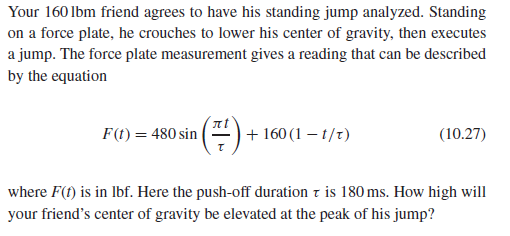Question

Transcribed Image Text:Your 160 lbm friend agrees to have his standing jump analyzed. Standing
on a force plate, he crouches to lower his center of gravity, then executes
a jump. The force plate measurement gives a reading that can be described
by the equation
(=)
F(t) = 480 sin
+ 160 (1 – t/t)
(10.27)
where F(f) is in lbf. Here the push-off duration z is 180 ms. How high will
your friend's center of gravity be elevated at the peak of his jump?
Expert Solution
This question has been solved!
Explore an expertly crafted, step-by-step solution for a thorough understanding of key concepts.
This is a popular solution
Trending nowThis is a popular solution!
Step by stepSolved in 2 steps

Knowledge Booster
Similar questions
- You are working with a movie director and investigating a scene with a cowboy sliding off a tree limb and falling onto the saddle of a moving horse. The distance of the fall is several meters, and the calculation shows a high probability of injury to the cowboy from the stunt. Let's look at a simpler situation. Suppose the director asks you to have the cowboy step off a platform 2.55 m off the ground and land on his feet on the ground. The cowboy keeps his legs straight as he falls, but then bends at the knees as soon as he touches the ground. This allows the center of mass of his body to move through a distance of 0.670 m before his body comes to rest. (Center of mass will be formally defined in Linear Momentum and Collisions.) You assume this motion to be under constant acceleration of the center of mass of his body. To assess the degree of danger to the cowboy in this stunt, you wish to calculate the average force upward on his body from the ground, as a multiple of the cowboy's…arrow_forwardWhat is the power in kW produced by the La Rance tidal power station in France if the usable tidal range is 10 m? The barrage is 140m long and the area of the basin behind the barrage is 22 km2. Tidal period is 12h 25minutes. Density of salt water is 1020 kg/m3. Use proper units and 3 significant figures.arrow_forwardAnswer within 5 minutesarrow_forward
- A lab assistant has suspended a spring from a door frame. When an object is attached to the spring's bottom end, the spring extends downward by an additional distance, d, measuring 4.80 cm. (That downward distance is relative to the unstretched position that the spring had previously held when in equilibrium, as shown by the horizontal dashed line in the figure below). Calculate the mass of the hanging object (in kg) if the spring constant k has the value 59.5 N/m. 1. kgarrow_forwardFigure MA mc Determine a formula for the magnitude of the force F exerted on the large block (mc) in the figure (Figure 1) so that the mass mA does not move relative to mc. Ignore all friction. Assume mp does not make contact with mc Express your answer in terms of the given quantities and appropriate constants. VE ΑΣΦ +m+m₂) • ( F = (MA !The correct answer does not depend on a. No credit lost. Try again. ?arrow_forwardApply error propagation to determine the associated uncertainty in the average volume… Plzarrow_forward
- Need in typing only or word file (no handwriting and no image, NO Plagiarism)arrow_forwardAn inclined plane of angle θhas a spring of force constant k fastened securely at the bottom so that the spring is parallel to the surface as shown. A block of mass m is placed on the plane at a distance d from the spring. From this position, the block is projected downward toward the spring with speed v. Calculate By what distance is the spring compressed when the block momentarily comes to rest? develop an equation for x. x when θ=30.0° , k = 1 kN/m, m = 5 kg, d = 0.5 m, and v =1 m/s. If we add another spring in series, by what distance is the spring compressed when the block momentarily comes to rest? If we add another spring in parallel, by what distance is the spring compressed when the block momentarily comes to rest? Part 3 & 4 are where I am strugglingarrow_forward
arrow_back_ios
arrow_forward_ios